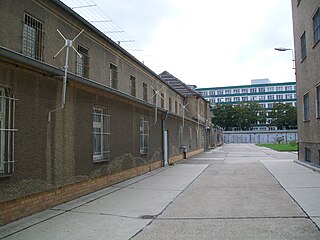 W
WThe Ministry for State Security or State Security Service, commonly known as the Stasi, was the official state security service of the German Democratic Republic. It has been described as one of the most effective and repressive intelligence and secret police agencies ever to have existed. The Stasi was headquartered in East Berlin, with an extensive complex in Berlin-Lichtenberg and several smaller facilities throughout the city. The Stasi motto was Schild und Schwert der Partei, referring to the ruling Socialist Unity Party of Germany and also echoing a theme of the KGB, the Soviet counterpart and close partner, with respect to its own ruling party, the Communist Party of the Soviet Union (CPSU). Erich Mielke was the Stasi's longest-serving chief, in power for 32 of the 40 years of the GDR's existence.
 W
WBautzen II was a 20th-century political prison in the town of Bautzen in Saxony operational during the communist regime in East Germany. It was the only East German prison directly under the control of the Stasi.
 W
WThe Berlin-Hohenschönhausen Memorial is a museum and memorial located in Berlin's north-eastern Lichtenberg district in the locality of Alt-Hohenschönhausen, part of the former borough of Hohenschönhausen. It was opened in 1994 on the site of the main political prison of the former East German Communist Ministry of State Security, the Stasi.
 W
WThe Sportvereinigung Dynamo was the sport association of the security agencies of former East Germany. The association was founded on 27 March 1953 and was headquartered in Hohenschönhausen in East Berlin. From the date of its inception until 23 November 1989 the president of the SV Dynamo was Erich Mielke, the Minister of State Security.
 W
WThe Felix Dzerzhinsky Guards Regiment was the paramilitary wing of the Ministry for State Security (Stasi), the security service of the German Democratic Republic (GDR).
 W
WThe Gesellschaft zur Rechtlichen und Humanitären Unterstützung (GRH) is a German historical revisionist organisation consisting of former employees of the East German secret police, the Stasi. It is led by the last Stasi chief, Wolfgang Schwanitz. In Germany the organisation is best known for its attempt to portray the Stasi in a positive light and for trivializing or denying the political repression in East Germany. It has become widely known in Germany for massively disturbing memorial ceremonies or other forms of public events relating to political repression in East Germany. It has also been accused of harassing victims of the East German regime, journalists, and politicians. GRH has been described by historian Hubertus Knabe, the Director of the Berlin-Hohenschönhausen Memorial, as an "aid association for state criminals."
 W
WHoheneck Women's Prison was a women's correctional facility in operation between 1862 and 2001 in Stollberg, Germany. It became most notable as a detention facility for female political prisoners in East Germany. The prison was designed to hold up to 600 inmates, however, as many as 1,600 were detained there.
 W
WThe Main Directorate for Reconnaissance was the foreign intelligence service of the Ministry of State Security (Stasi), the main security agency of the German Democratic Republic, from 1955 to 1990.
 W
WThe Memorial and Education Centre Andreasstraße, is a museum in Erfurt, Germany, which is housed in a former prison used by the East German Ministry for State Security (Stasi). It is informally known as the Stasi Museum.
 W
WStasi Decorations and Memorabilia, by Ralph Pickard is a three volume in-depth analysis of the socialist political culture of the Ministry for State Security (Stasi) of the German Democratic Republic (GDR). It provides a rare insight to this clandestine organization using never seen before artifacts such as medals, certificates and objects to document the Stasi culture of awards and recognition.(1,2) Altogether, all three volumes contain over 900 pages with over 1700 illustrations.
 W
WThe Wieger StG-940 was an East German series of assault rifles loosely based upon the Kalashnikov AK-74. The StG-940 was chambered in 5.56×45mm NATO and the StG-942 in 5.45×39mm M74.
 W
WZersetzung is a psychological warfare technique used by the Ministry for State Security (Stasi) to repress political opponents in East Germany during the 1970s and 1980s. Zersetzung served to combat alleged and actual dissidents through covert means, using secret methods of abusive control and psychological manipulation to prevent anti-government activities.